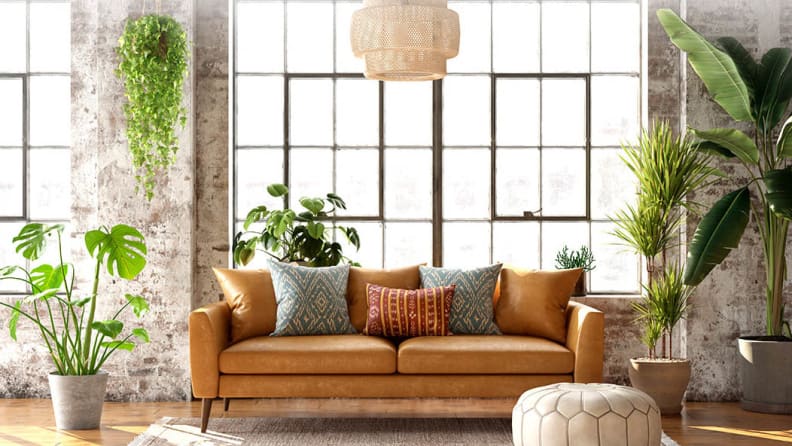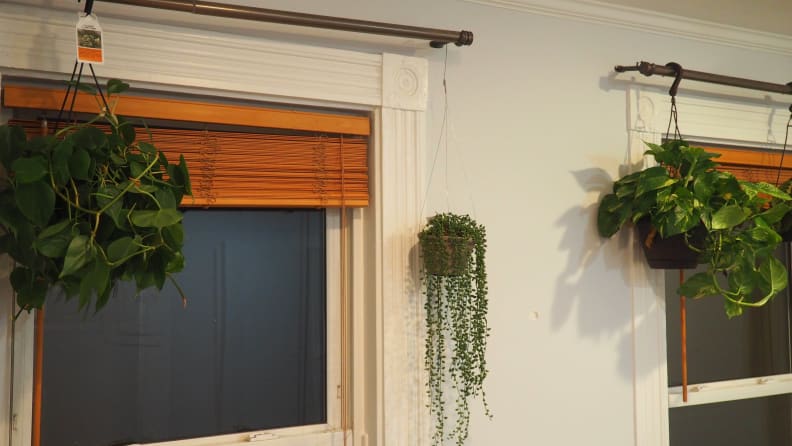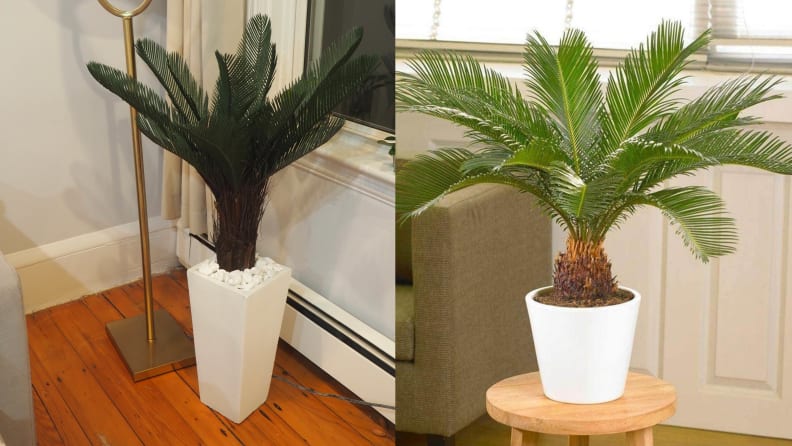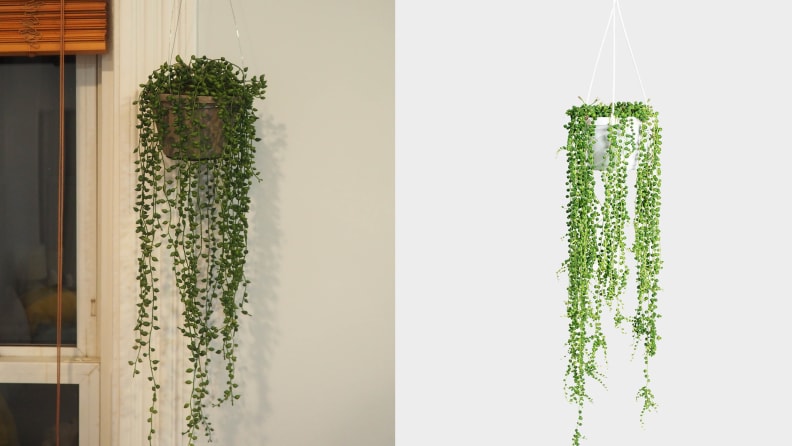Nearly Natural claims its fake plants look like the real thing—but do they?
Are you team faux foliage?
Products are chosen independently by our editors. Purchases made through our links may earn us a commission.
As a proud plant parent, the idea of faux foliage has never quite sat right with me. Sure, I see the appeal for someone who's not a self-proclaimed green thumb: Fake plants don't require watering, repotting, or natural light. You never have to get your hands dirty dealing with cuttings, bugs, soil, or fertilizer (or worry about which ones are toxic to pets). They are truly a match made in heaven for low-maintenance folks who still want to liven up their space. And yet, with all these benefits, I still can't join the fake plant movement—I love tending to my potted friends and watching them flourish before my eyes.
In order to see if even I, an artificial plant hater, could be swayed by this no-fuss greenery, I looked to Nearly Natural, a popular online retailer for fake fauna of all kinds—fiddle leaf fig trees, succulents, and silk flowers among them. I swallowed my pride and selected two faux plants to be placed among their alive counterparts in my apartment. Keep reading to see if I emerged a faux plant convert!
What is Nearly Natural?

The company claims the plants “look so real, they’re Nearly Natural!”
Nearly Natural is one of the leading companies in the artificial plant business and carries thousands of faux plants and flowers available in a variety of different species. In order to make plants appear as realistic as possible, the company relies on horticulturists with real-life experience in the live plant industry to come up with designs.
While most fake plants are constructed from silk and/or plastic, according to Nearly Natural, they use a blend of materials: "Our artificial plants are made from plastic, polyester, and other high-quality materials like silk."
How do you order plants from Nearly Natural?
Nearly Natural plants can be found at many major retailers, including Bed, Bath & Beyond, Home Depot, and Wayfair, but you may find the most selection from shopping directly on its site. The company carries an assortment of faux greenery in every category, from silk trees, silk plants, and silk flowers to outdoor plants, wreaths, and garlands. There's also a variety of planters to choose from should you wish to repot your fake plant into a new vessel. Nearly Natural makes it easy to shop based on species and variety of plant, and also offers the option to narrow down product selection based on measurements and price.
When shopping on the site, you may want to have a picture of the real plant handy to compare the appearance of its leaves, stems, and lifelike qualities to the fake version. You'll also want to consider the plant's placement in your home—especially if you're trying to fool even the most discerning of houseguests. One tip is to read any customer reviews before deciding, as many shoppers include pictures and details of the material, size, and texture of the plant.
How much do Nearly Natural plants cost?

Can you tell which plant is faux?
Nearly Natural plants range in price, but most float around the $50 to $200 mark depending on dimensions. While they don't exactly come cheap, one thing to keep in mind is these are plants won't require any care, save for an occasional dusting. Compare this to the price of real plants that may wilt or eventually die, and they may be the better home decor investment to some.
With the aim of testing both a large and small fake plant, I chose the 3-foot Cycas Tree in White Tower Planter ($119.99), as well as the adorable String of Pearl Artificial Plant Hanging Basket ($59.99).
What I thought of Nearly Natural plants
Cycas tree (Sago palm)

Neither the trunk nor the leaves of the Sago Palm I received (left) were as realistic as an alive version (right).
Upon the arrival of my artificial plants, I was first struck with how securely packaged they were, delivered in padded boxes and carefully wrapped in protective plastic. After the unboxing process, I also opened the baggie of white rocks and loaded them into the base of the Cycas tree. The foliage of the Cycas came folded up against the stem of the tree, which I carefully pulled down and tried to shape into a natural appearance. Each branch of the Cycas has a flexible wire within it, so you can bend them and twist them to your liking.
While rearranging the leaves, I did find that the Cycas had a hard, plasticky feel, and I felt that the leaves did not have much variation in terms of color or length. I wished the plant had a few more "imperfections" to give it a more realistic look, and that the lower branches had been long enough for me to fan the plant out. These qualities, to me, were a dead giveaway that it was fake. (Full disclosure: I grew up with a Sago palm in my parents' kitchen that was quite majestic, so I had high expectations for this plant which fell short in the end).
String of Pearls

The String of Pearls plant I tested (left) is almost indistinguishable from its live twin (right).
Next up was the String of Pearls, which came with an attached hanger that I easily hooked onto the top of the curtain rod in my living room. I had a more positive reaction to the String of Pearl's appearance, as I found its tendrils each had a varying length that contributed to its natural look. I also loved the little stone planter that it came in, as it wasn't as flashy as the Cycas' white planter and bright river rocks, which didn't blend in as well with the rest of my aesthetic.
In comparing the look and feel of the Cycas and String of Pearl to their alive counterparts, I definitely realized just how important the fake plant selection process is. I definitely recommend picking a species that won't stick out amongst the living plants in your home, and making sure the planter appears to be a realistic environment for it to grow in. While I originally thought the Cycas would be a fun, tropical addition to my space, it was a bit too conspicuous next to my other plants.
Should you order fake plants from Nearly Natural?
While I haven't fully shed my aversion to fake plants, there's certainly some major perks to this type of low-maintenance greenery. Whether you're looking to fill out your indoor jungle oasis with a few faux look-alikes or add some lushness to the low-light corners of your home, it's certainly worth scoping out what Nearly Natural has to offer. Personally, I'd steer clear of artificial substitutes that look a little too "perfect" or symmetrical, as well as plants that wouldn't thrive naturally in the spot you place them in—that's where I went wrong!
Keep your eye out for options with varying leaf distribution as well as those with a naturally “plastic-y” look: Fiddle leaf figs, Ficus, Aloe, Pothos, Philodendrons, and Peperomia might just be your best bet should you go the faux route.
